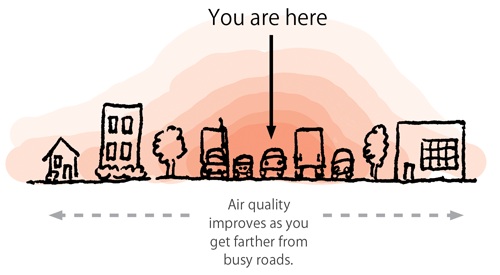|
Access to clean, healthy air is something all Minnesotan’s deserve. More than half of air pollution comes from things we drive or power equipment we use. Highest levels of air pollution reach you while in your car driving down a busy highway or street. Bumper-to-bumper or not, the density of vehicles creates a tunnel of unhealthy air that you can’t avoid breathing.
 Compared to other states around the country, Minnesota ranks high in overall air quality. Even on good air quality days, you can limit exposure to air pollutants by minimizing the time you spend near busy roadways, idling vehicles, construction equipment, and burning activities such as recreational fires.
Poor air quality can affect lung and heart health. Consider especially those in certain at-risk groups including children, people with heart or lung issues and those who exercise or work vigorously outside. For instance, this time of year, vehicle exhaust is a powerful asthma trigger. An asthmatic child in my neighborhood is so affected by the fumes that her parents encourage all neighbors to limit time spent warming up their cars on bitter cold days. Nevertheless, even people who are otherwise healthy may experience health effects when pollution increases. Some Minnesotan cities, including Minneapolis, are taking action to reduce unnecessary vehicle idling and passing anti-idling ordinances—resulting in cleaner air for everyone.
The Air Quality Index
The Air Quality Index, or AQI, is a measure of air pollution
created by the U.S. Environmental Protection Agency to provide a uniform way to
report daily air conditions. Like a measuring stick, it helps us understand how
clean our air is and how it is changing over time.
Be air aware
|
Like a weather forecast, you can use AQI results and air quality forecasts to reduce your exposure to unhealthy levels of air pollution. The Minnesota Air App, available for iPhone, Android and Windows, and the MPCA’s AQI website provide daily AQI forecasts and real-time air quality conditions to help you plan your activities and protect your health. Air quality conditions are updated hourly for cities across Minnesota. Daily air quality forecasts are available for the Twin Cities and Rochester.
You can also get air quality alerts and forecasts through email, Twitter or even get texts sent to your phone.
|
|
 |
What does bad air look like?
In the winter, certain weather conditions can create high
levels of fine particle pollution. Fine particles come from diesel, gasoline,
industry, wood burning and chemical reactions in the air. While individual fine
particles are not visible to the naked eye, high levels of fine particle
pollution can reduce visibility. MPCA’s live
haze camera feeds give an indication of air clarity, which is affected by
fine particle pollution. Air pollution that causes
haze can come from man-made sources, such as factories and cars, or natural
sources like dust, wildfires, and volcanoes. Play with the slider below
to simulate what Minneapolis might look like with increasing levels of fine
particle air pollution.

How do we compare?
In the past year, Minneapolis- St. Paul had 5 days with a
fine particle or ozone AQI value over 100, including one day above 150. 218
days were in the Good category with AQIs 0-50. Take a look at other cities across
the US. More data is available at www.epa.gov/airdata.
- Los Angeles: 106 days above 100 on the Air
Quality Index (AQI) , including 11 between 151-200
- Phoenix: 94 days above 100 AQI including 8
between 150 and 200 and 8 days over 200
- Chicago: 47 days above 100 AQI including 10 days
above 150
What are 5 things you can do to make air healthier for all Minnesotans?
-
Choose
a cleaner commute. Drive your car less—Carpool. Bike. Bus. Telecommute. Be
creative.
-
Keep your car in good
repair. Fix exhaust and oxygen sensor problems ASAP. Check tire pressure
monthly.
-
Burn
only dry, untreated wood. No garbage. No painted or varnished wood. Especially,
don’t burn during air quality alerts.
-
Use
less energy. Insulate your house well. Turn off electrical stuff you’re not
using. It all adds up.
-
Turn off your engine. An idling
engine creates a hot spot of pollution. Buses and big trucks particularly
produce unhealthy exhaust.
Attend Hennepin County’s upcoming Mend-It Clinic and get help
restoring clothing and other soft goods from volunteers with sewing skills.
Bring items such as clothes, bags, linens or curtains. Volunteers can fix
broken hems/seams, buttons, belt loops, rips, zippers, stuffed toys and much
more in order to save those goods from being dumped in the trash. January 25,
noon-3 p.m., Northeast Library (Minneapolis).
Join the Minnesota Zoo and their next Our World Speaker
Series—Attracting Birds, Butterflies and
Other Backyard Wildlife. Bring nature to your backyard by learning how to
create wildlife-friendly gardens and restore the ecological health of your
neighborhood. January 22, 7:00-9:00 p.m. (Apple Valley).
It may be cold, but you can still enjoy the outdoors in the
middle of winter. Learn how to snowshoe at Maplewood’s Winter Open
House. Sleds will be available for pulling young kids. January 18, 10:00
a.m.-3:00 p.m., Maplewood Nature Center (Maplewood).
Back to
Basics: “Hope For The Future” will be promoting sustainable living through
workshops, speakers, activities and more. Topics include eco-friendly tips such
as energy awareness and greener living. February 1, 8 a.m.-4:30 p.m., Pine
River-Backus High School (Pine River).
Attention
youth in grades 4-12! The Will Steger Foundation and Minnesota Pollution
Control Agency are sponsoring the Youth
Voices of Change: Climate Change Video Competition. To
participate, just create a video that shows how you are engaging in solutions
to climate change in your home, school or community. Videos are due by May 16,
2014. Ten finalist videos will be chosen and the competition winners will be
announced the evening of August 22, 2014 on the Sustainability Stage at the Eco
Experience at the State Fair.
Send questions or comments about living green to the address
below.
Sincerely,
Taylor Holland and the Living Green Team
livinggreen365.pca@state.mn.us
|